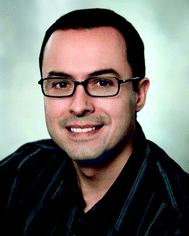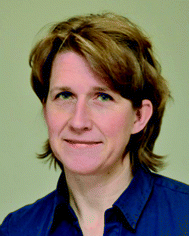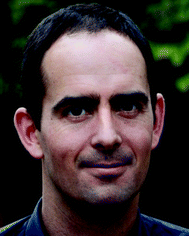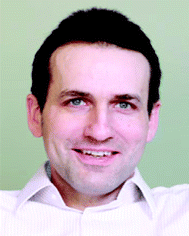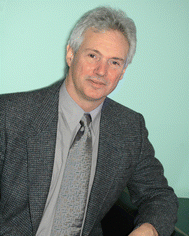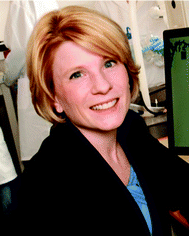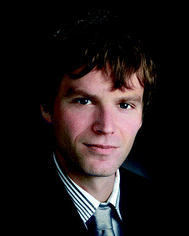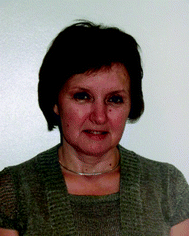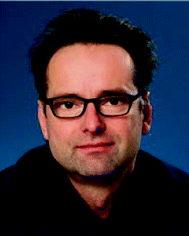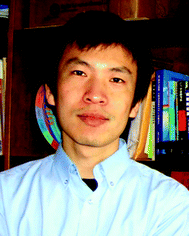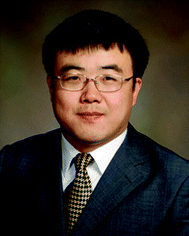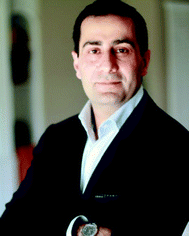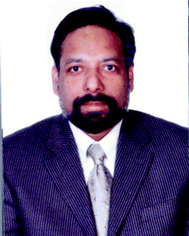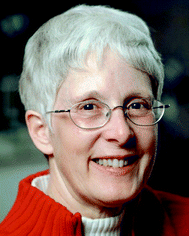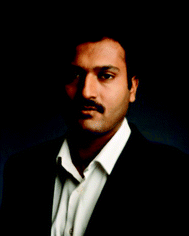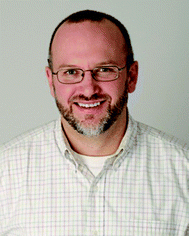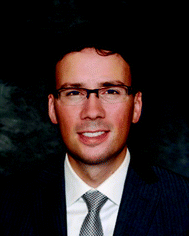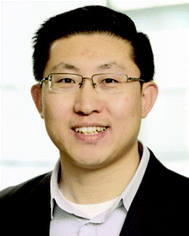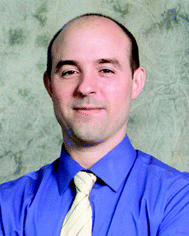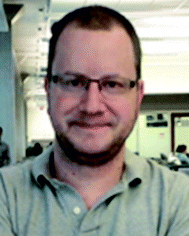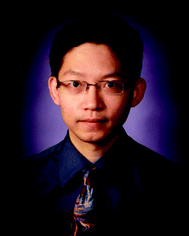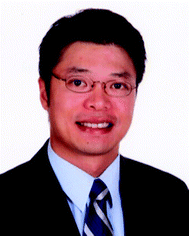DOI: 10.1039/C3LC90053C
(Profile)
Lab Chip, 2013, 13, 2433-2437
Canadian contributors 2013
Carlos Escobedo
Carlos Escobedo is Assistant Professor at the Department of Chemical Engineering at Queen's University. He received a BSc from the National University of Mexico (UNAM), MASc from University of Toronto and PhD degree from University of Victoria, Canada. He worked in the R&D biomedical sector between his masters and doctoral studies and has lectured at three different universities in Canada and Mexico. From 2011 to 2013, he was NSERC postdoctoral fellow with tenure at the Department of Biosystems Science and Engineering at ETH Zürich, Switzerland. His research focuses on the development of integrated sensing platforms stemming from the combination of small-scale fluidics and nanoplasmonic structures, relevant to biomedical and environmental applications.
Anja Geitmann
Anja Geitmann is professor at the Département de sciences biologiques of the Université de Montréal. She is an expert in plant cell biology and cytomechanics. After studies in Germany, the US and Sweden, Dr Geitmann obtained her PhD in 1997 from the University of Siena, Italy. Her training includes postdoctoral fellowships in Canada and the Netherlands. Dr Geitmann is editor for the journals Plant Physiology, Journal of Integrative Plant Cell Biology, Frontiers in Plant Biology and BMC Plant Biology. She is Vice-President of the Microscopical Society of Canada, member of the Executive of the Canadian Society of Plant Biologists, Member of the Board of Trustees of the Canadian Foundation for the Development of Microscopy, and Newsletter Editor of the International Association of Sexual Plant Reproduction Research.
Reuven Gordon
Reuven Gordon received his PhD in Physics from the University of Cambridge. In 2002, he joined the University of Victoria, where he currently holds a Canada Research Chair in Nanoplasmonics and an Associate Professor position in the Department of Electrical and Computer Engineering. In 2009, Dr Gordon was a visiting Professor at the Institute for Photonic Sciences (Barcelona, Spain). Dr Gordon's research group investigates how the nanostructuring of metals can allow us to reach out to single molecules, through optical trapping, spectroscopy, and sensing, for applications including drug discovery and the early detection of cancers.
Axel Guenther
Dr Guenther is an Associate Professor and Wallace G. Chalmers Chair of Engineering Design at the University of Toronto (UT). He obtained his doctoral degree from the Swiss Federal Institute of Technology (ETH) in Zurich and conducted postdoctoral research at the Massachusetts Institute of Technology. He received the ETH medal in 2002, the Ontario Early Researcher Award in 2009, the I. W. Smith Award of the Canadian Society of Mechanical Engineers in 2010, and the UT Inventor of the Year Award in 2013. He has invented several licensed microfluidic technologies. Together with colleagues, Dr Guenther is a co-organizer of the local microfluidics meeting “Ontario-on-a-Chip” and currently serves as the Scientific Director of the Centre for Microfluidic Systems in Chemistry and Biology in Toronto. Dr Guenther's research team is interested in fluidic microprocessors for applications in the materials and the life sciences.
D. Jed Harrison
Prof. D. Jed Harrison, is a native of Vancouver, Canada. He received a BSc from Simon Fraser University in Chemical Physics, and a PhD from M.I.T. in Inorganic Chemistry. His research focus since joining the faculty of Chemistry at the University of Alberta in 1984 has been in the application of micro-fabrication technologies to chemical and biochemical analysis. His research work in the past 20 years has largely been in the field of microfluidics, and is the recipient of a number of national and international awards for this research. He is currently the Chairman of the Department of Chemistry.
Shana Kelley
Shana Kelley is a Professor of Chemistry, Biochemistry, Pharmaceutical Sciences, and Biomedical Engineering at the University of Toronto. Her research interests span a variety of areas, including the development of clinical diagnostic devices and drug delivery systems. Kelley obtained her PhD at Caltech, and was a NIH postdoctoral fellow at Scripps Research Institute. Shana has received a number of awards, including a Dreyfus Fellowship, Sloan Fellowship, NSF Career Award and the Steacie Prize. She has co-founded two companies; GeneOhm Sciences and Xagenic Inc.
Erik Kjeang
Dr. Erik Kjeang is an Assistant Professor in Mechatronic Systems Engineering at Simon Fraser University in Vancouver, Canada. Dr. Kjeang has more than ten years’ experience in clean energy systems and fuel cell R&D at leading organizations in Canada and Sweden. He currently leads a $12M university–industry collaborative project on polymer electrolyte fuel cells. His pioneering work on microfluidic fuel cells and redox batteries has been awarded with the prestigious Governor General’s Gold Medal and resulted in patented technology, two book chapters, invited conference talks, and more than a dozen scientific publications in the top journals of this field.
Eugenia Kumacheva
Eugenia Kumacheva is the Canada Research Chair in Advanced Polymer Materials. She received her PhD in Physical Chemistry of Polymers at the Institute of Physical Chemistry (Russian Academy of Science). She did her postdoctoral research in Polymer Physics at the Weizmann Institute of Science. Since 1996 Eugenia Kumacheva has been a Professor in the Department of Chemistry at the University of Toronto. Her research interests include microfluidics, advanced polymer and hybrid materials, colloid and interface science, nanoscience and self-assembly.
Lothar Lilge
Dr Lilge studied at the universities of Frankfurt and Muenster where he obtained respective degrees in Physics (diploma) and Biophysics (PhD). He spent a period of 3 years at the Wellman Lab of Photomedicine at Massachusetts General Hospital. Postdocs were completed at McMaster University and the Ontario Cancer Institute. Since 1996, he has held a faculty position at the Department of Medical Biophysics at University of Toronto. His research interests are in optical diagnostics, photodynamic therapy and the development of novel microfluidic tools for molecular and cell biology.
Francis Lin
Francis Lin received his PhD in Physics from the University of California, Irvine, in the USA in 2004. He then did his postdoctoral research at Stanford University School of Medicine from 2005 to 2008. He joined the University of Manitoba in Canada as an Assistant Professor in the Department of Physics and Astronomy in December 2008. His research interest is in applying interdisciplinary approaches to better understand immune cell trafficking in complex tissue environments, and in developing microfluidic systems for biomedical applications.
Xinyu Liu
Xinyu Liu is an Assistant Professor of the Department of Mechanical Engineering at McGill University. He received his PhD degree from the University of Toronto in 2009. Prior to joining McGill in 2011, he was a NSERC Postdoctoral Fellow in the Department of Chemistry and Chemical Biology at Harvard University. He is a Chwang-Seto Faculty Scholar at McGill University. He received the Douglas R. Colton Medal for Research Excellence, the Canadian Rising Star in Global Health Award, and several best paper awards at engineering and biomedical conferences. His research interests include paper-based microfluidics for low-cost bioanalysis, automated microfluidic instrumentation for high-throughput screening, and microrobotic manipulation of cells and small organisms.
Farshid Mostowfi
Farshid Mostowfi is a senior scientist and the program manager of the Novel Fluid Analysis research group at Schlumberger in Edmonton, Canada. He received his PhD in Mechanical Engineering from the University of Alberta in 2007. Dr Mostowfi's primary interests are in development and commercialization of microfluidic technologies for characterization of reservoir fluids in the oil and gas industry. He has been a lead inventor in a number of technologies for compositional and phase behavior analysis of crude oils. He also served as an adjunct Professor of Engineering at the University of Alberta.
Muthukumaran Packirisamy
Muthukumaran Packirisamy is a Professor and Concordia Research Chair on Optical BioMEMS in the Department of Mechanical and Industrial Engineering, Concordia University, Canada. He a Fellow of American Society of Mechanical Engineers, Fellow of Institution of Engineers, Fellow and recipient of the I. W. Smith award from the Canadian society for Mechanical Engineers, Concordia University Research Fellow, Petro Canada Young Innovator Award and ENCS Young Research Achievement Award. His research interests include optical bioMEMS, integration of microsystems and micro–nano integration. He obtained his PhD from Concordia University, Masters from the Indian Institute of Technology, Madras, India and Bachelors from University of Madras, India. He has also worked for many MEMS industries in Canada. He is presently involved with developing bioMEMS devices in collaboration with different industries. As an author of more than 300 articles published in journals and conference proceedings; Professor Packirisamy has nine patents in the area of micro-systems. He has supervised more than 9 Research Associates, 16 PhDs and 45 Masters students. He was successful in obtaining grants worth more than $9 million.
Linda M. Pilarski
Linda Pilarski is Professor in the Department of Oncology and Senior Scientist at the Cross Cancer Institute. From 2003–2010, she held the Tier I Canada Research Chair in Biomedical Nanotechnology. In 2009, she won the Alberta Science and Technology Award for Outstanding Leadership in Alberta Technology. She leads the Alberta Heritage Foundation for Medical Research Interdisciplinary “Team Microfluidics”. This is a research initiative to develop miniaturized testing technology for use in the clinic, with a focus on a novel platform that can simultaneously test multiple samples for multiple targets to create diagnostic test panels for specific conditions.
P. Ravi Selvaganapathy
Dr P. Ravi Selvaganapathy is an Associate Professor in mechanical engineering and the Canada Research Chair in Biomicrofluidics at McMaster University, Canada. He completed his BS in chemical and electrochemical engineering in 1998 from the Central Electrochemical Research Institute, India. He obtained his MS and PhD in electrical engineering in 2002 from University of Michigan, Ann Arbor. He was a postdoctoral fellow at Sandia National Laboratories from 2003–2004 and joined McMaster University in 2005. His research interests are in the development of microfluidic devices for drug discovery, drug delivery, environmental diagnostics and model organ systems.
Craig Simmons
Craig Simmons is an Associate Professor of Mechanical and Biomedical Engineering at the University of Toronto and the Canada Research Chair in Mechanobiology. He received his PhD from the University of Toronto in 2000, followed by postdoctoral fellowships at the University of Michigan and the University of Pennsylvania. His research group studies the mechanisms by which mechanical forces regulate cell function, with the goal of developing improved therapies to treat or replace diseased tissues. Specific focuses include the pathobiology of heart valve disease, strategies to regenerate tissues using stem cells, and the development of microdevices to study cell mechanobiology.
David Sinton
David Sinton is an Associate Professor in the Department of Mechanical and Industrial Engineering, and the Director of the Institute for Sustainable Energy at the University of Toronto. His research interests are in microfluidics for energy applications. Prior to joining the University of Toronto, he was an Associate Professor and Canada Research Chair at the University of Victoria, British Columbia (2003–2011), and Visiting Associate Professor at Cornell University (2009–2010).
Yu Sun
Yu Sun is a Professor in the Department of Mechanical and Industrial Engineering, with joint appointments in the Institute of Biomaterials and Biomedical Engineering and the Department of Electrical and Computer Engineering at the University of Toronto. He is the Director of the University's Nanofabrication Center and the Canada Research Chair in Micro and Nano Engineering Systems. His PhD was in mechanical engineering from the University of Minnesota in 2003. His postdoc training was at ETH Zürich in 2003–2004. His research group specializes in the manipulation and characterization of single cells, molecules, and nanomaterials using microdevice and micro–nanorobotic approaches.
Aaron Wheeler
Aaron Wheeler completed his PhD in Chemistry in 2003, working with Dick Zare at Stanford University, and then spent two years as an NIH postdoctoral fellow at UCLA. Since 2005, Wheeler has been the Canada Research Chair of Bioanalytical Chemistry at the University of Toronto, with a primary appointment in the Chemistry Department and cross-appointments at the Institute for Biomaterials and Bioengineering and the Banting and Best Department of Medical Research. Along with David Juncker and David Sinton, Wheeler is the guest editor of this themed issue of Lab on a Chip.
Derek J. Wilson
Derek J. Wilson started his scientific career by studying drama and vocal performance in the Arts York high school program in Markham, Ontario. Shunning the fame and fortune he would inevitably have garnered as a broadway superstar, Derek enrolled in the biochemistry program at Trent University in Peterborough where he did his undergraduate thesis under Dr Steven Rafferty. This was followed by a bioanalytical mass-spectrometry oriented PhD at Western University (then the more sensibly named 'University of Western Ontario') under Dr Lars Konermann and later a bioanalytical NMR-oriented, NSERC-funded postdoc under Chris Dobson at Cambridge.
Jun Yang
Jun Yang received his Bachelor's degree, Master's degree and PhD degree all in Mechanical Engineering, and completed his postdoctoral training in biomedical and mechanical engineering. He joined the University of Western Ontario in September 2005. He is now an associate professor in the Department of Mechanical and Materials Engineering, and has a joint appointment with the Biomedical Engineering Program of The University of Western Ontario. He is also an honorary research scientist of Surface Science Western of this university. His research interests include lab on a chip, nanofabrication, MEMS, biophysics and biosensors, surface science and engineering, and advanced functional materials.
John T. W. Yeow
John T. W. Yeow received his BASc degree in Electrical and Computer Engineering, and MASc and PhD degrees in Mechanical and Industrial Engineering from the University of Toronto, Canada. He is currently a Professor and a Canada Research Chair in Micro/Nanodevices in the Department of Systems Design Engineering at the University of Waterloo, Canada. His current research interests are in the field of developing miniaturized biomedical instruments. He is the Editor-in-Chief of the IEEE Nanotechnology Council Newsletter. He is also an Associate Editor of the IEEE Nanotechnology Magazine and the IEEE Transactions on Nanotechnology.
| This journal is © The Royal Society of Chemistry 2013 |

